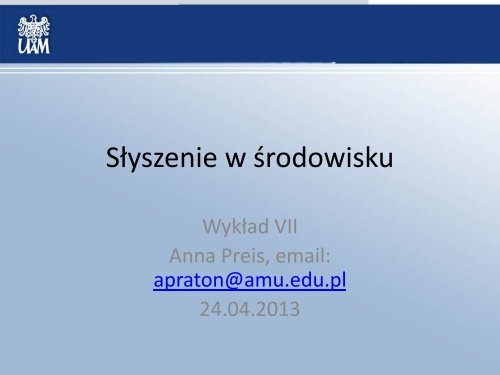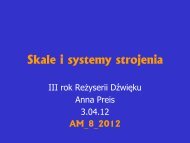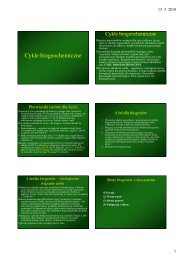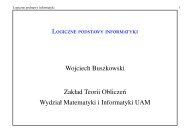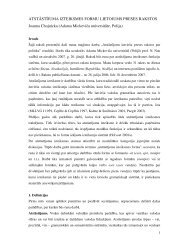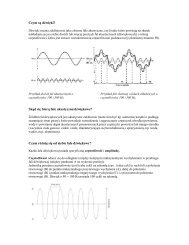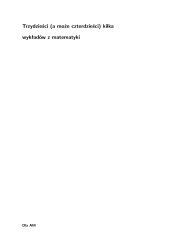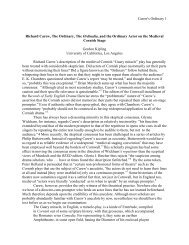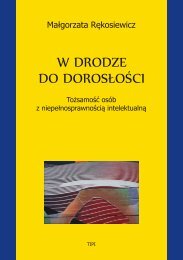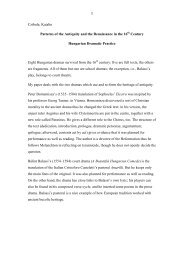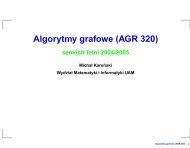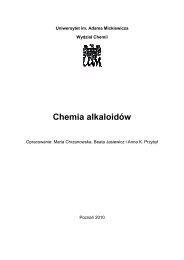Noise annoyance and its measurement
Noise annoyance and its measurement
Noise annoyance and its measurement
Create successful ePaper yourself
Turn your PDF publications into a flip-book with our unique Google optimized e-Paper software.
Słyszenie w środowisku<br />
Wykład VII<br />
Anna Preis, email:<br />
apraton@amu.edu.pl<br />
24.04.2013
How to test if soundscape changes into noisescape?<br />
<strong>Noise</strong> <strong>annoyance</strong> <strong>and</strong> <strong>its</strong> <strong>measurement</strong><br />
Anna Preis<br />
apraton@amu.edu.pl
L<strong>and</strong>scapes
Soundscape
Soundscape<br />
The Tuning of the World formalized the soundscape terminology Schafer had devised<br />
during his field studies with the WSP:<br />
Background sounds he defined as “keynotes” (in analogy to music where a keynote<br />
identifies the fundamental tonality of a composition around which the music<br />
modulates);<br />
Foreground sounds (intended to attract attention) are termed “sound signals.”<br />
Sounds that are particularly regarded by a community <strong>and</strong> <strong>its</strong> visitors are called<br />
“soundmarks”—in analogy to l<strong>and</strong>marks.<br />
Natural examples of the latter include geysers, waterfalls <strong>and</strong> wind traps while<br />
cultural examples include distinctive bells <strong>and</strong> the sounds of traditional activities.<br />
(Schafer 1977a: 9, 55-56, 173-175, 272-275; Truax 1978: 68, 119, 127; 1984: 22,<br />
58-60).<br />
K. Wrightson, (2000) An Introduction to Acoustic Ecology.The Journal of Acoustic<br />
Ecology, 1(1).<br />
Soundscape exists through human perception of the acoustic environment<br />
A. L. Brown (2010) Soundscapes <strong>and</strong> environmental noise management <strong>Noise</strong><br />
Control Eng. J., 58(5)
Underst<strong>and</strong>ing urban <strong>and</strong> natural soundscapes<br />
• Dick Botteldooren, Department of Information Technology, Ghent University, Gent,<br />
Belgium.<br />
• Catherine Lav<strong>and</strong>ier, Laboratory MRTE, University of Cergy Pontoise, F-95000<br />
Cergy Pontoise, France<br />
• Anna Preis, Institute of Acoustics, Adam Mickiewicz University, Poznan, Pol<strong>and</strong><br />
• Daniele Dubois, Institut Jean le Rond d'Alembert, Equipe LAM, CNRS, France,<br />
INCAS3, Assen, The Netherl<strong>and</strong>s.<br />
• Itziar Aspuru, Labein-Tecnalia, Environmental Unit, Spain<br />
• Catherine Guastavino, McGill University, School of Information Studies <strong>and</strong><br />
CIRMMT (Centre for Interdisciplinary Research on Music, Media <strong>and</strong> Technology),<br />
Montréal, QC, Canada.<br />
• Lex Brown, Griffith School of Environment, Griffith University, Nathan 4111,<br />
Australia<br />
• Mats Nilsson, Department of Psychology, Stockholm University, Sweden<br />
• Tjeerd C. Andringa, Artificial Intelligence, University of Groningen, The<br />
Netherl<strong>and</strong>s. INCAS3, Assen, TheNetherl<strong>and</strong>s.<br />
Working Group 1 of the COST action<br />
“Soundscapes of European cities <strong>and</strong><br />
l<strong>and</strong>scapes”
Professor Lex Brown, Griffith University, Australia<br />
<strong>Noise</strong> Control<br />
Approach<br />
Sound as waste<br />
Concerns sound of discomfort<br />
Human response related to<br />
level of sound<br />
Measures by integrating across<br />
all sound sources<br />
Manages by reducing level<br />
Soundscape Approach<br />
Sound as resource<br />
Concerns sounds of preference<br />
Preference often unrelated to<br />
level - quiet not the objective<br />
Requires differentiation<br />
between sound sources –<br />
wanted sound from unwanted<br />
sound<br />
Manages by “wanted sounds”<br />
masking “unwanted sounds”
Sound environment versus noise environment<br />
Soundscape<br />
• Perception <strong>and</strong> recognition of<br />
different sound sources in the<br />
environment<br />
• Soundscape perception: auditory<br />
scene analysis based on streams<br />
segregation<br />
• Criteria of segregation: loudness,<br />
pitch, timbre, location<br />
• Scaling the preferences of<br />
different soundscapes<br />
<strong>Noise</strong>scape<br />
• Occurrence of noise which disturbs<br />
perception to such a degree that it is<br />
impossible to recognize sound sources in<br />
the environment<br />
• <strong>Noise</strong>scape as a source of disturbance of<br />
human activity such as communication,<br />
work, studying<br />
• <strong>Noise</strong>scape threshold: degree of<br />
disturbance which makes the<br />
performance of a given activity<br />
ineffective<br />
• Speech intelligibility in noise is well<br />
defined <strong>and</strong> could be a measure of noise<br />
<strong>annoyance</strong> related to communication<br />
activity
Disturbed l<strong>and</strong>scape
Disturbed soundscape = noisecape<br />
White noise<br />
Specific noise
<strong>Noise</strong> <strong>annoyance</strong><br />
Traditional approach<br />
• L DEN one noise index<br />
• <strong>Noise</strong> maps for different sound<br />
sources<br />
• St<strong>and</strong>ardized method of noise<br />
<strong>annoyance</strong> scaling<br />
• <strong>Noise</strong> parameter is scaled<br />
• Annoyance is related to noise<br />
parameter<br />
• (Dose –response characteristics<br />
%HA versus L DEN )<br />
<strong>Noise</strong>scape approach<br />
• Difficulty in performing a<br />
given activity disturbed by<br />
noise is scaled<br />
• The degree of difficulty in<br />
performing a given activity is<br />
a measure of noise<br />
<strong>annoyance</strong> assessment<br />
• <strong>Noise</strong> <strong>annoyance</strong> assessment<br />
depends on the degree of<br />
disturbance in the human<br />
activity
Traditional approach: noise <strong>annoyance</strong> in rest<br />
• ISO/TS 15660:2003, recommended by ICBEN<br />
• verbal rating scale: Thinking about the last (...12 months or so),when<br />
you are here at home, how much does noise from (….noise source...)<br />
bother, disturb, or annoy you?<br />
• (1) Not at all? (2) Slightly? (3) Moderately? (4) Very? (5) Extremely?<br />
• numerical rating scale: Thinking about the last (...12 months or<br />
so),what number from zero to ten best shows how much you are<br />
bothered, disturbed, or annoyed by the presented noise events?<br />
• If you are not at all annoyed choose zero, if you are extremely<br />
annoyed choose ten, if you are somewhere in between, choose a<br />
number between zero <strong>and</strong> ten.<br />
Preis, A., Kaczmarek, T., Wojciechowska, H., Żera, J., Fields, J.M. (2003), "Polish version of the st<strong>and</strong>ardized noise<br />
reaction questions for the community noise surveys," International Journal of Medicine <strong>and</strong> environmental Health<br />
16(2): 155-159
<strong>Noise</strong> <strong>annoyance</strong> related to rest <strong>and</strong><br />
communication activity<br />
• <strong>Noise</strong> disturbs<br />
rest<br />
• <strong>Noise</strong> disturbs<br />
communication activity<br />
traditional scaling of<br />
noise <strong>annoyance</strong> (ISO/TS<br />
15660:2003,<br />
recommended by ICBEN)<br />
verbal rating scale<br />
numerical rating scale<br />
difficulty of comprehending<br />
speech in noise is a<br />
measure of noise<br />
<strong>annoyance</strong><br />
speech intelligibility score
<strong>Noise</strong> <strong>annoyance</strong> scale related to noise parameters<br />
sound<br />
parameters of<br />
sound increase<br />
L, S, R, F<br />
different models<br />
of noise <strong>annoyance</strong><br />
unwanted sound<br />
= NOISE<br />
<strong>Noise</strong> <strong>annoyance</strong> scale related to communication - speech intelligibility scores<br />
work<br />
work<br />
disturbance<br />
<strong>Noise</strong>scape- measure of work<br />
disturbance<br />
soundscape<br />
noise<br />
communication<br />
communication<br />
disturbance<br />
<strong>Noise</strong>scape-measure of<br />
communication disturbance<br />
Speech<br />
intelligibility in<br />
noise<br />
rest<br />
rest<br />
disturbance<br />
<strong>Noise</strong>scape- measure of rest<br />
disturbance
Rest<br />
<strong>Noise</strong> <strong>annoyance</strong> scaling
<strong>Noise</strong> <strong>annoyance</strong> scaling<br />
Communication activity
<strong>Noise</strong>scape related to the communication activity<br />
Equal difficulty in speech recognition<br />
Equal <strong>annoyance</strong> rating<br />
SRT ---- 50% speech recognition<br />
Averaged speech reception thresholds for nine<br />
environmental noises expressed as an arithmetical<br />
means <strong>and</strong> 95% of coincidence interval.<br />
The measure of difficulty of speech comprehension<br />
for nine noises expressed as medians <strong>and</strong> their<br />
interquartile ranges.<br />
A. Preis, H. Hafke-Dys, T. Kaczmarek, T. Gjestl<strong>and</strong> (2011) The relationship between speech reception thresholds <strong>and</strong> the<br />
assessment of <strong>annoyance</strong> caused by different environmental noises <strong>Noise</strong> Control Eng. J. 59 (4), 408-414.
One point relationship between noise <strong>annoyance</strong><br />
<strong>and</strong> speech intelligibility<br />
Difficulty in speech<br />
comprehension<br />
<strong>annoyance</strong> related to<br />
communication activity<br />
Speech intelligibility<br />
What about the other points?
The relationship between speech intelligibility <strong>and</strong><br />
the assessment of <strong>annoyance</strong> caused by<br />
environmental noises<br />
Anna Preis, Honorata Hafke-Dys, Tomasz Kaczmarek<br />
Institute of Acoustics, Adam Mickiewicz University, Poznan, Pol<strong>and</strong><br />
Truls Gjestl<strong>and</strong><br />
SINTEF ICT, Trondheim, Norway
Aim of the study<br />
To find out if the speech intelligibility in noise can be<br />
used as the <strong>annoyance</strong> measure of this noise<br />
To assess the difficulty in speech comprehension in<br />
noise<br />
• Aniansson, G., Bjὂrkman, M., “Traffic noise <strong>annoyance</strong> <strong>and</strong> speech intelligibility in persons with normal<br />
<strong>and</strong> person with impaired hearing” Journal of Sound <strong>and</strong> Vibration 88(1), 99-106, (1983).<br />
• Ellis L.W, Pakulski L., “Judgments of speech intelligibility <strong>and</strong> speech <strong>annoyance</strong> by mothers of children<br />
who are deaf or hard of hearing” Perceptual <strong>and</strong> motor skills 96, 324-8, (2003).
<strong>Noise</strong> L AeqT (dB) SRT (dB)<br />
Bus_in 83.5 -28.6<br />
Tram_1_in 76.5 -23.4<br />
Train_out 75.0 -20.4<br />
Tram_out 73.9 -15.1<br />
Street 73.8 -13.0<br />
School_in 73.5 -10.0<br />
Plane_out 71.8 -9.8<br />
Babble noise 68.2 -7.7<br />
50% speech intelligibility<br />
Speech level was 65dB <strong>and</strong> noise level was respectively -6, -4, -2,<br />
0=SRT, 2, 4, 6. Each subject was presented with his SRT from the<br />
previous experiment
Experiments<br />
Experiment I:<br />
part 1: speech intelligibility was measured for eight<br />
environmental noises at seven signal-to-noise ratios (SNRs).<br />
part 2: for these SNR values, the participants assessed the<br />
difficulty in speech comprehension<br />
Experiment II:<br />
the st<strong>and</strong>ard method of noise <strong>annoyance</strong> assessment was used<br />
to the same noises as in Experiment I<br />
Participants<br />
nineteen university students, 8 males <strong>and</strong> 11 females aged<br />
between 20 <strong>and</strong> 25, took part in both psychoacoustic<br />
experiments
Are they equal or not?<br />
Annoyance related to<br />
communication activity<br />
• difficulty in speech<br />
comprehension<br />
Annoyance related to<br />
the rest<br />
• traditional noise <strong>annoyance</strong><br />
assessment<br />
speech communication<br />
rest?<br />
Experiment 1 part 2 Experiment 2
Speech samples<br />
The Polish sentence matrix test (PSMT). The speech was presented to<br />
the participants at the constant level of 65 SPL.<br />
The PSMT consists of 10 names, 10 verbs, 10 numerals, 10 adjectives,<br />
<strong>and</strong> 10 nouns, i.e. a total of 50 different words that can be used<br />
to build 100000 different sentences. More details <strong>and</strong> properties of<br />
a PSMT can be found in Ozimek et al., 2010.
<strong>Noise</strong> samples - maskers<br />
• noise in a school corridor during the break.<br />
• a busy road taken about 35 meters from the middle of the<br />
road.<br />
• a bus interior (Neoplan) during normal drive conditions.<br />
• a tram type 105N2k-2000 interior during the normal drive<br />
conditions.<br />
• a jet airplane over-flight.<br />
• an Inter-City train pass-by taken 25 m from the rail track.<br />
• a tram type 105n pass-by taken 25 m from the rail track.<br />
• babble noise (uniform noise created from a speech by<br />
averaging a large number of a Polish-language speech<br />
material).
Experiment I - part 1:<br />
Psychometric curve for speech intelligibility scores<br />
• The method of constant stimuli was used to obtain the<br />
speech intelligibility function for 7 values of SNR: -6 dB, -4<br />
dB, -2 dB, 0 dB, 2 dB, 4 dB, 6 dB. (SNR 0dB=SRT)<br />
• Each masker (8 environmental noises) was presented with a<br />
list of 20 sentences consisting of 5 r<strong>and</strong>omly chosen words<br />
from the Polish sentence matrix test (PSMT)<br />
• After the utterance of a sentence, a five column (names,<br />
verbs, numerals, adjectives) - 50-word push-button panel<br />
was displayed on an LCD screen. The participants’ task was<br />
to indicate words from the played-back sentence <strong>and</strong><br />
confirm their choice with the ‘OK’ button
Experiment I - part 2:<br />
Assessment of difficulty in speech comprehension<br />
After each utterance the participants were prompted to assess their difficulty in<br />
comprehending speech on an ascending scale from 0 to 10, where 0 means not at all<br />
difficult <strong>and</strong> 10 extremely difficult<br />
Push-button with a question about the difficulty in speech comprehension
Experiment I -results
Experiment I: results presented for each SNR
A<strong>annoyance</strong> rating – speech intelligibility<br />
y=9.0403e -0.749x
Experiment II:<br />
Assessment of noise <strong>annoyance</strong> presented alone<br />
Push-button with the question about the noise <strong>annoyance</strong><br />
scaling
Comparison of <strong>annoyance</strong> assessment
Results of Experiment I <strong>and</strong> II
Comparison of <strong>annoyance</strong> assessment
Conclusions<br />
• The best approximation of the relationship between the speech<br />
intelligibility <strong>and</strong> difficulty in speech comprehension is the following<br />
exponential function y=9.0403e -0.749x . This relationship was<br />
obtained for 7 different SNR values of eight environmental noises<br />
(Experiment I)<br />
• The differences between <strong>annoyance</strong> ratings which were assigned to<br />
the same noises during different activities, are not statistically<br />
significant (Experiment I <strong>and</strong> II) for SNR= 0, 2, 4, 6.<br />
• The outcome of this study is restricted to the situation where<br />
speech is presented to the listener at 65 dB sound level <strong>and</strong> the<br />
Polish sentence matrix test (PSMT) test is applied
• Thank you for your kind attention!<br />
• Dr Honorata Hafke-Dys, dr Tomasz Kaczmarek – co-authors of<br />
the presented results<br />
• Mgr Paweł Libiszewski , dr Jędrzej Kociński –technical<br />
assistance<br />
• This work was supported by the grant from the Polish-<br />
Norwegian Research Fund – project no. PNRF-167-AI-1/07.
Polish-Norwegian Research Fund<br />
Quality of public life determined by good hearing <strong>and</strong> speech<br />
communication<br />
SP 1<br />
Auditory research in the light of<br />
speech intelligibility<br />
SP 2<br />
Speech intelligibility as an index of the<br />
quality of public life<br />
WP 1<br />
Development of<br />
new sentence<br />
intelligibility tests<br />
for children <strong>and</strong><br />
improvement of<br />
recently designed<br />
tests for adults<br />
WP 2<br />
Development of new<br />
environment noise <strong>annoyance</strong><br />
index related to intelligibility<br />
data<br />
WP 3<br />
Application of new<br />
intelligibility tests to<br />
assessment of acoustic<br />
quality of hearing aids<br />
<strong>and</strong> implants<br />
WP 4<br />
Intelligibility tests aimed at<br />
evaluation of acoustic<br />
quality of public buildings<br />
<strong>and</strong> improvement of<br />
Internet <strong>and</strong> telephone<br />
procedures for self-testing<br />
intelligibility


